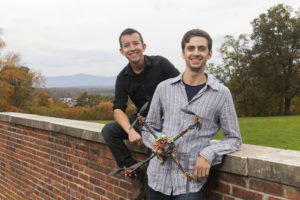 The Bard College Center for the Study of the Drone has published another report offering significant insight into drone use in the U.S. The Center’s Drone Registrations: A Preliminary Analysis, written by Center co-founders Dan Gettinger and Arthur Holland Michel, analyzes data from over 900,000 recreational and commercial drone registrations to get a snapshot of drones in U.S. – and the results are surprising.
The Bard College Center for the Study of the Drone has published another report offering significant insight into drone use in the U.S. The Center’s Drone Registrations: A Preliminary Analysis, written by Center co-founders Dan Gettinger and Arthur Holland Michel, analyzes data from over 900,000 recreational and commercial drone registrations to get a snapshot of drones in U.S. – and the results are surprising.
“Today, as Congress is set to reinstate the registration requirement for hobbyists, we released a report analyzing over 940,000 FAA drone registrations up to October 31,” says Gettinger. “Unlike previous FAA data releases, this dataset contains the non-hobbyist aircraft type and registration timestamp, allowing for a closer look at the drone industry.”
The sheer number of registrations – especially given the controversy over the recreational registration program – is impressive. “As of October 31, 2017, there are 836,796 hobbyist users and 106,739 non-hobbyist drones registered with the Federal Aviation Administration,” says the report. The data includes international registrations – which come from 123 different countries.
Among the surprises in the key takeaways: Non-hobbyist drone registrations have increased in 2017, while hobbyist user registrations have decreased. While that’s a surprise to the general public – most of whom have only ever seen a recreational drone – the drone industry itself has been betting heavily on the commercial sector to far outweigh recreational drones. And it looks like the big players have been successful in bringing their consumer models into the pro space.
“The 30 most common non-hobbyist drones account for 88 percent of all non-hobbyist registered systems,” says the report. What’s less surprising is which company takes the lead: “The most popular non-hobbyist drone is the DJI Phantom 4. Drones made by the China-based DJI account for at least 70 percent of all non-hobbyist drones.”
The location of commercial drones is also intriguing: the report concludes that “States with low population densities are more likely to have high rates of non-hobbyist drone registrations.” That makes sense from an application standpoint – agriculture and energy are still major industry verticals – and California and Texas are the expected states to top the list. Illinois, Pennsylvania, and Virginia, however are less commonly recognized as industry centers; but make the top ten. Even more interesting is the breakdown of the number of commercial drones per capita in each state – looked at that way, Alaska, Idaho and North Dakota top the list of registered commercial drones.
The report can be read here – the Center offers a variety of reports and analysis on industry and regulatory trends.

Miriam McNabb is the Editor-in-Chief of DRONELIFE and CEO of JobForDrones, a professional drone services marketplace, and a fascinated observer of the emerging drone industry and the regulatory environment for drones. Miriam has penned over 3,000 articles focused on the commercial drone space and is an international speaker and recognized figure in the industry. Miriam has a degree from the University of Chicago and over 20 years of experience in high tech sales and marketing for new technologies.
For drone industry consulting or writing, Email Miriam.
TWITTER:@spaldingbarker
Subscribe to DroneLife here.







[…] post The Bard College Center for the Study of the Drone has Analyzed Over 900,000 Drone Registrations in … appeared first on […]